|
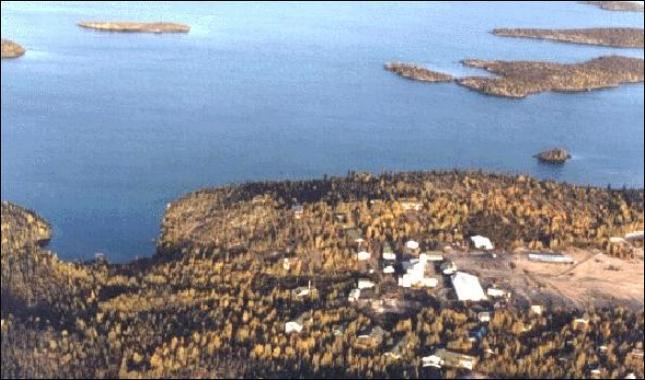
Aerial view of Discovery Mine Property on
west side of Giauque Lake.
|
The
Great Gold Heist
By
Bonnie Wayne McGuire
|
During
1980 we were exploring Canada's Northwest
Territories. One of our most memorable stops was to
visit the Northern Museum at Fort Smith. It had all
sorts of interesting things to see, but the most
fascinating was a story about the great gold bars
theft in the 1950's by a man named Tony Gregson.
I've often thought it would make a great movie.
Tony was a colorful
character who didn't like the ordinary, humdrum way
of doing things. He was easy going, seemed well
educated, was athletic, handsome and popular. He
carried off the gold in 1954, eluded authorities
until his arrest in 1957, and was sentenced to 30
months in prison. During his freedom he had a good
time spending and traveling.
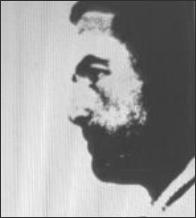
Evidently, Ralph Hedland wrote
the museum's story about him in
Maclean's magazine.
He knew Tony had just been released from prison
in 1960, so went to interview him at some mine
where he was allegedly working. Those he
inquired said "Tony had left to parts unknown."
All the miners gave me the same story...Gregson
had "pulled the pin" a month before and left no
forwarding address. Later the boss said, "It
wasn't true...that Tony was there, either at the
chute, or the local bar; that the men felt Tony
had paid his debt, and didn't cater to strangers
asking questions." Finally, Hedland "found him
in the beer parlor...a stocky, cleancut man with
a scar under his right eye, the "distinguishing
feature" described in posters that had been
pinned up in hundreds of police stations and
post offices across Canada. A few minutes later
in my hotel room, Gregson (right), a big cigar in the
corner of his mouth and a bottle of beer in
hand, settled down to discuss what he called the
gold-brick affair. "
When he was fifteen Tony enlisted in the
British army. Later he joined the Scottish army
and traveled Europe. He didn't like doing things
in a dull way, so after his army days he stowed
away on a ship to America. Then he sneaked into
Canada by hiding under a bridge at the border.
He got caught, but the Authority in charge was
fascinated by his story, so let him stay if he
promised to work in the meat packing plant for a
year. He complied and then moved on to Northwest
Territories where he worked in Yellowknife
before moving on to Consolidated Discovery Mine.
It was about sixty miles to the north and only
accessible by bush plane or winter Cat train.
After working there a little over a year, he
told the mine manager that he was moving on.
This was normal for single men employed at
remote mines. There wasn't anywhere to spend
money, so they saved a lot in a short time. For
most, the isolation became boring, and they
longed for adventure. The manager was sorry Tony
was leaving and told him he'd have a job waiting
if he decided to return.
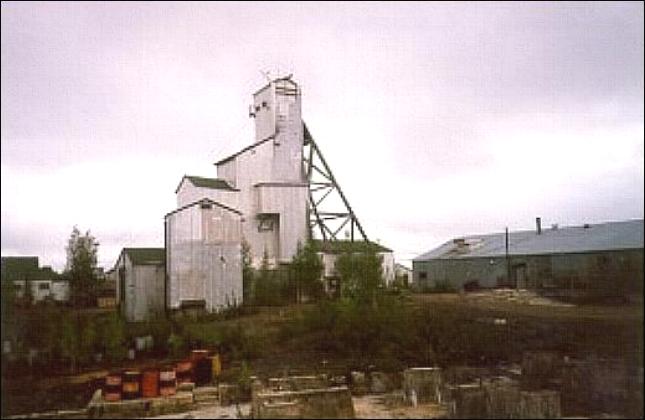
Discovery Mine head frame
Tony had noticed miners carelessly
putting gold bullion on sleds and sending it to
the bank with an Indian. This gave him an idea
he began working on. He got a job with a mining
company, and had a man make him two lead bricks.
He stashed a boat, food, supplies and reading
materials at Yellowknife. Finally, just before
the weekend, he quit his job at the mine. The
mine had a 72 and 52 pound gold brick ready for
shipment to the Yellowknife bank that day. Tony,
another man and the pilot took off in a plane.
The other man and the pilot sat in front while
Tony took the seat in the back. It was a tedious
flight during which the two passengers slept
part of the time. The pilot made a stop, and
when he got out Tony switched bags. His looked
just like the mines...right down to the stamp,
or so it appeared. When they reached
Yellowknife, and were leaving the plane, the
pilot helped him unload his gear. "What've you
got in here...a gold brick?" the pilot joked.
"Just geiger," Tony replied. He hurried to his
stashed boat...assuming it wouldn't be long
before the theft would be realized. The boat
motor wouldn't start. He worked on it for an
hour before it finally ran. Since the police
hadn't shown up, he changed his plans about
holing up somewhere along the lake for the
season. Instead, he headed for a city where he
could get lost.
The theft wasn't discovered until
Monday. A clerk noticed that the number on the
bags and weight didn't match his data. He phoned
the mine, and a warrant was issued to arrest
Tony Gregson on sight for theft. But Tony was
long gone. (I can't remember where). He'd taken
a plane to some city in another province and
sent a letter to a friend living in an area in
the opposite direction to his location...where
the authorities were searching. He instructed
the friend to mail the letter inside the
letter...to the mine. The letter was a request
that the mine give his back pay to "The Society
For the Prevention of Cruelty to Animals." This
sent police scurrying to the area postmarked on
the letter.
Meanwhile, Tony bought a hacksaw that he
used to saw off slices of gold he turned into
cash. The shavings and dust were put in an
aspirin bottle for later. Eventually he bought a
fishing boat for $3,500. The captain wanted
cash, rather than gold. Tony hired a crew,
bought supplies and they were soon on their way.
He now went by the name of Anthony Johnson. When
they weren't fishing they partied. They only
fished to make it appear that was how Tony
earned his living, and sold their catch at
various ports.
His trail grew cold with his change of
profession, and because he didn't have a steady
girlfriend, or visit old friends. Eventually
Tony paid the crew and sold the boat. One
evening two men knocked on his door. He thought
they'd finally caught up with him. The gold was
in the closet on the floor under some clothes.
However, the men were merely checking on one of
his employees concerning a minor
infraction....never realizing the gold was
nearby.
Tony traveled to Los Angeles, California
for awhile, and then to Cuba. When he tried to
sell some more gold, the authorities got wind of
it and told him to leave...which he was anxious
to do. He went back to Canada and returned to
working in mines. By now he was number 10 on the
Mounties's most wanted men's list. They put out
posters with his picture. (He had a scar on his
cheek.) People recognized him and reported it.
The trail grew hot.
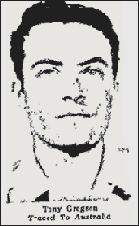
Sometimes a couple of days or 24 hours
separated him from the detectives. Eventually he
stowed away on a ship going to Australia. He went
four days without food or water before making
his presence known...making sure they were far
enough away from Canada. The ship's Captain
tried to put him off in different countries, but
they refused to take him. In Sydney he spent
fourteen days in jail while his fingerprints
were run through the records of the ICAP...the
international police organization of which
Canada and Australia are both members. On the
tenth day the police asked him if he was Tony
Gregson, wanted in Yellowknife.
"I admitted it right away. You might as
well be sporting about it when you've lost.
But, you know, the only reason they had my
prints was because I got drunk in
Yellowknife and started shooting out the
lights with a .22 and another time pinched a
truck."
The final identification was made in
Australia on June 14, 1957, just a few
days short of three years from the time
Gregson had hoisted the gold bricks. He
was met at Father Point, Quebec, on
August 14 by Corporal Bill Campbell of
the Hay River detachment of the RCMP who
had chased him all those years. taken
back to Yellowknife.
Tony asked him, "You
always get your man eh?" The
officer chuckled, "Well, it's a little tougher than
in the comics." A fascinated lawyer took Tony's
case. The gold was gone, and Tony was sentenced to
30 months in prison. (For
more of the story read excerpts from
"Advocate For The North"
by Frank Wade, and
Amazing Flight and Flyers.)
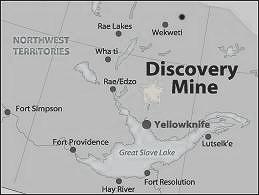
Epilogue
Saturday November 26, 2011 Tony's niece emailed me:
"I came across your website when searching the web
to see if there was any more information about my
uncle, the colourful Tony Gregson. It was great to
read your 'Great Gold Heist' story about him, and
the Judge John Parker page as well. I already have
the excerpt from Maclean's (?) Magazine, which has a
wonderful picture of him smoking a cigar when being
interviewed at a hotel, which your story mentioned.
I have often wondered whether
he ever had any children, and where they are. I know
he had a wife - Doris I think her name was... We
last heard from his wife in the 70s when she wrote
asking for money and saying Tony was dead - my
parents discovered he wasn't! In the 80s, he was
living somewhere called Calder or Calter (or
Culter?) Lake, north of Yellowknife, as I have a
letter from him that someone gave me. But he seems
to have disappeared after that. Not sure whether the
Cuba stories etc are true. I think he just died a
recluse in Canada, myself, probably under a
pseudonym.
It may interest
you to know that Anthony had some other interesting
aspects to his life. His father,
Captain WH Gregson, was the last owner of
England's most famous haunted house, Borley Rectory
(if you search the web there are lots of stories
about that). Anthony was quite young, my father Alan
was a couple of years older. They experienced many
strange phenomena, but unfortunately the rectory
burned down while my grandfather owned it. Anthony,
who didn't get on with his father, wrote a letter to
a Borley historian claiming that his father had
burned down the place for insurance - but I'm
assured this isn't true!
Anyway
- I agree with you that Anthony's life would make a
great movie, and it was good to read more of his
exploits on your web page."
Leonie Gregson
**************************
 Thursday,
February 28, 2013 Michael Howdon inquired,
"My name is Michael Howdon from Kent in S/E
England. I stumbled across your blog about Tony
Gregson when googling 'Gold Heists' for an
illustration art project. It fascinated me! Such a
simple heist and an enthralling story. I'm now doing
my project on Tony Gregson and am going to
illustrate parts of his life. I've got 'Amazing
Flight and Flyers' which has part of his story in. I
was wondering if you could give me some more
direction... I absolutely agree, there is so much
visual material to his life it would be great to see
a movie made... I'd love to be able to talk to one
of his actual relatives! So far I've found him in
the Ottawa Citizen from 1957; a news report on his
capture in Australia. Shame about the museum, would
you by chance have the name of it?" Thursday,
February 28, 2013 Michael Howdon inquired,
"My name is Michael Howdon from Kent in S/E
England. I stumbled across your blog about Tony
Gregson when googling 'Gold Heists' for an
illustration art project. It fascinated me! Such a
simple heist and an enthralling story. I'm now doing
my project on Tony Gregson and am going to
illustrate parts of his life. I've got 'Amazing
Flight and Flyers' which has part of his story in. I
was wondering if you could give me some more
direction... I absolutely agree, there is so much
visual material to his life it would be great to see
a movie made... I'd love to be able to talk to one
of his actual relatives! So far I've found him in
the Ottawa Citizen from 1957; a news report on his
capture in Australia. Shame about the museum, would
you by chance have the name of it?"
http://mchowdondesign.blogspot.com/
Thanks so much Michael
for your research and contributions of newspaper
clips, Maclean's Magazine article and Amazing Flight
and Flyers article.
|
|